I fold the tuna and seasonings into the rice itself for my mixed tuna omusubi. That way every bite is uniformly flavored. They’re bold, savory, sweet, umami and almost meaty. And since Japanese rice balls are the original grab and go snack, I wrap these up, toss them in my bag and devour one whenever I’m out and about and need a boost of protein.
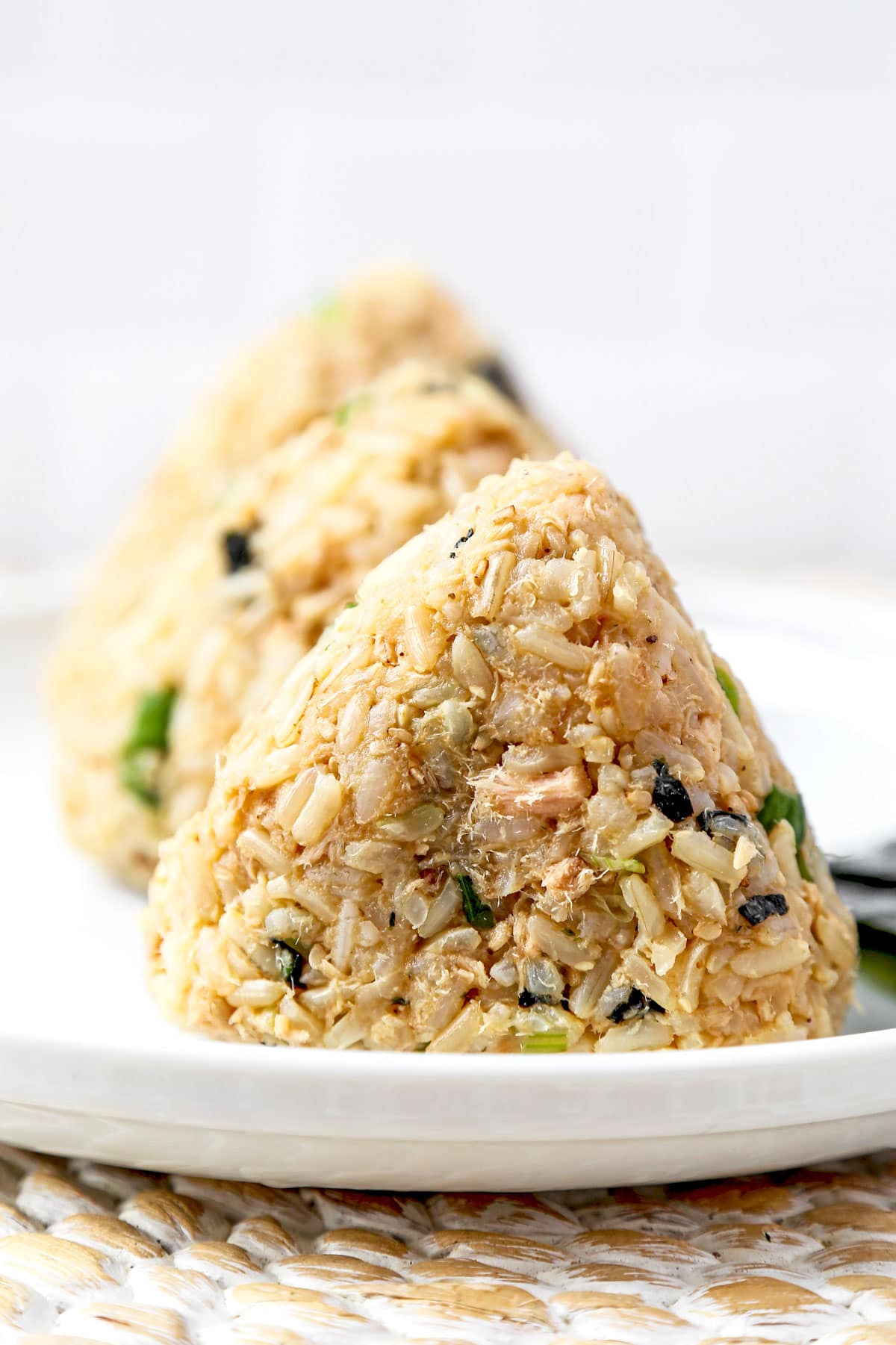
My mom taught me how to make onigiri when I was a kid. Once I learned the proper amount of filling to use (and the right amount of pressure to form a rice ball), I started making them ALL THE TIME. But I still bought them at the convenience store, because I loved unwrapping the complexly folded plastic. And, even though Japanese convenience store tuna mayo onigiri might be my favorite snack of all time, there’s something to be said for a rice ball that has the filling evenly distributed. That way every bite can be equally delicious. And that’s why I made these tuna omusubi with the savory tuna, smoky bonito flakes and crunchy green onions folded into the rice itself.
I flavor it all with soy sauce, mirin and sesame oil. And instead of using nori sheets to wrap the rice balls, I shred it into the mixture instead so there’s a toasted flavor throughout.
Table of Contents
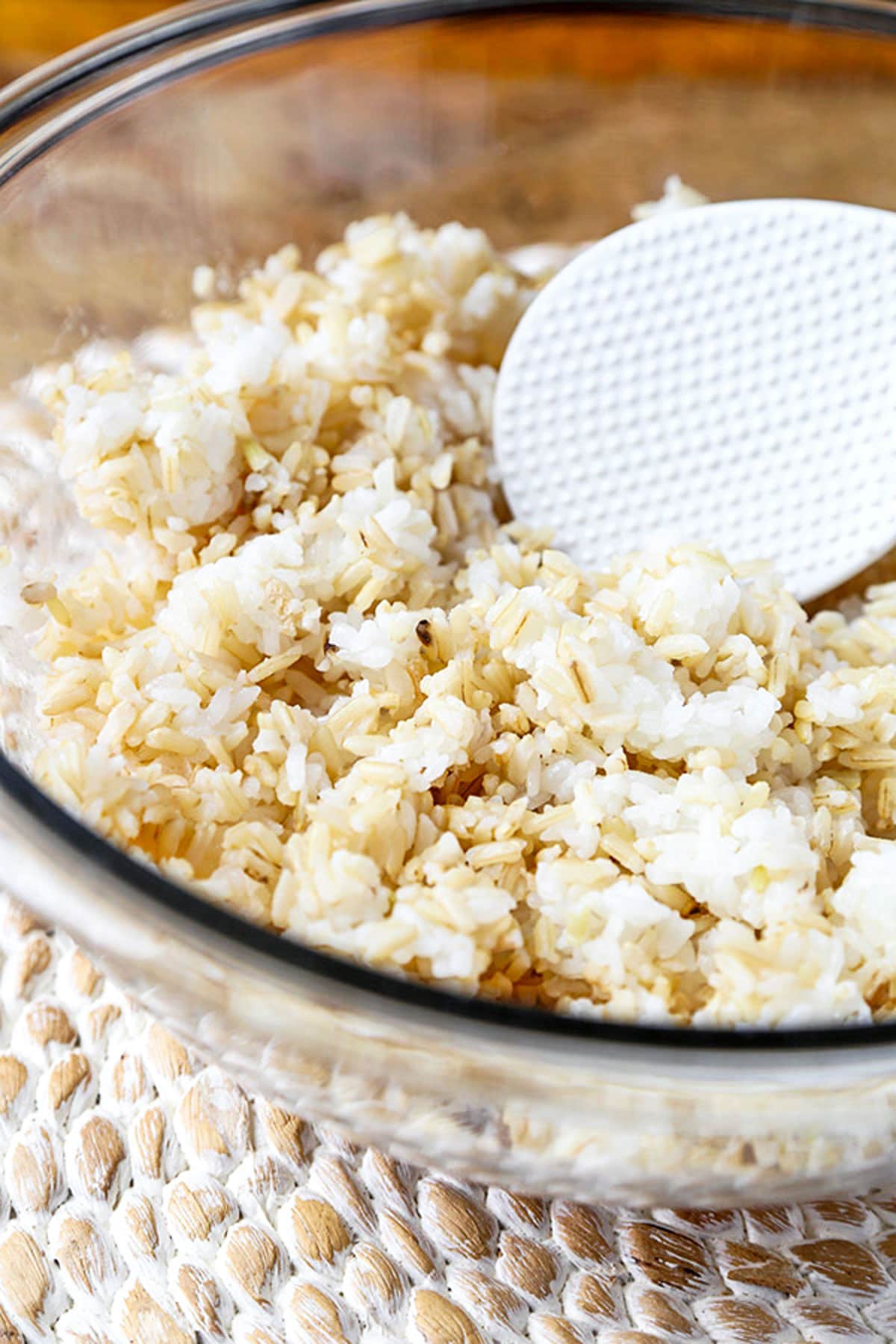
Ingredients
Scroll to the bottom of this page for the full recipe steps and measurements.
- Cooked Rice: I use a 50/50 combination of short grain Japanese white rice and brown rice. It needs to be short grain rice so the rice balls will hold together. A longer grain like jasmine rice doesn’t work when making omusubi.
- Canned Tuna: I prefer tuna canned in water. Oil packed tuna works in a pinch, but the flaky texture of the tuna in water is subjectively better for this recipe.
- Bonito Flakes: These ribbon thin dried fish flakes are smoky, salty and perfect.
- Sesame Seeds
- Green Onions: I slice these thinly for a little verdant crunch.
- Shredded Nori: These are the toasted thin seaweed sheets rice balls are usually wrapped in. I shred this into the mixture for this recipe instead.
Liquid Seasoning
I mix 3 ingredients. Soy sauce, mirin and sesame oil.
Why it works: The saltiness of the soy sauce is countered by the brightness and mild sweetness of the mirin. Sesame oil adds a touch of toasted nuttiness that works hand in hand with the sesame seeds in the omusubi filling.
Be sure to properly drain the canned tuna. The moisture from the packing liquid can make the rice balls soggy. To do this, place the tuna into a strainer and lightly press on the flakes to remove the excess water.
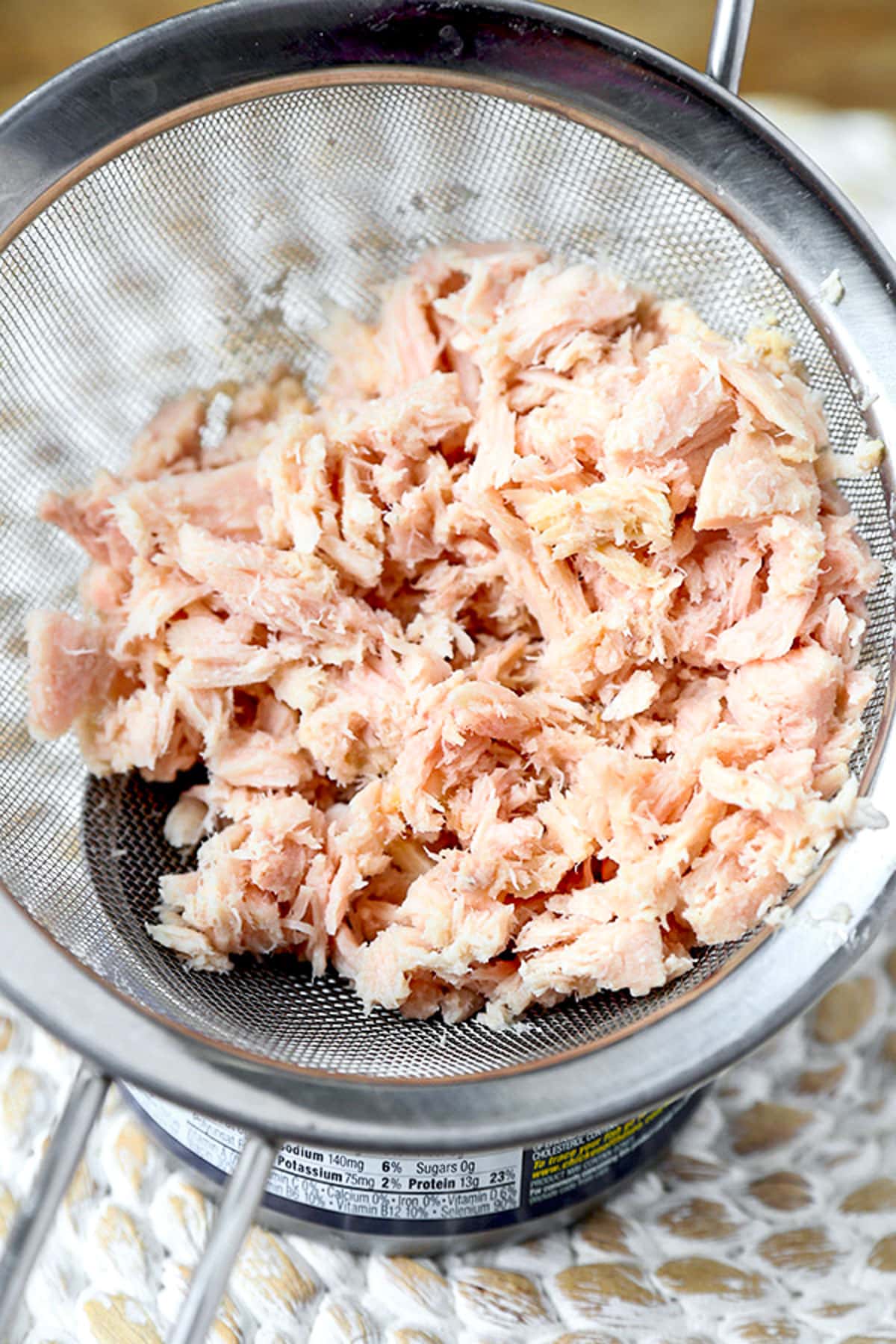
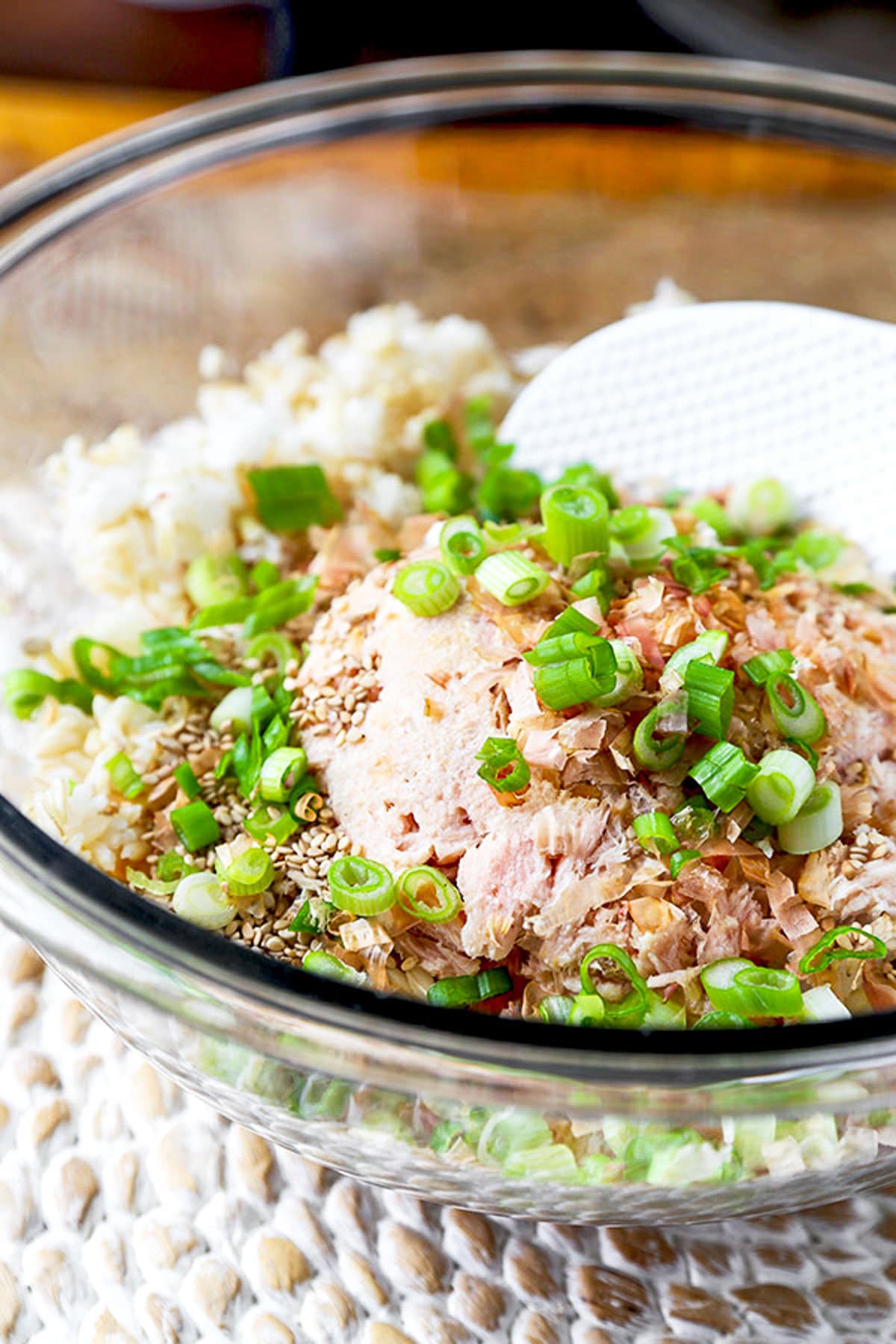
How To Make It
- Mix the rice. Gently fold the cooked white rice and brown rice together in a bowl.
- Fold in the tuna and dry ingredients. Mix well, but gently so the rice grains don’t break down and become mushy.
- Add liquid ingredients and gently fold the rice again.
- Form the rice balls. Make each omusubi with about 3/4 cup of filling. See the recipe card below for forming instructions.
Folding the rice is the key here. I use a plastic rice paddle or a wooden spoon to gently fold the rice grains with the filling. Everything should be incorporated – but the rice grains shouldn’t excessively break in the process. A fork will probably do more damage than good.
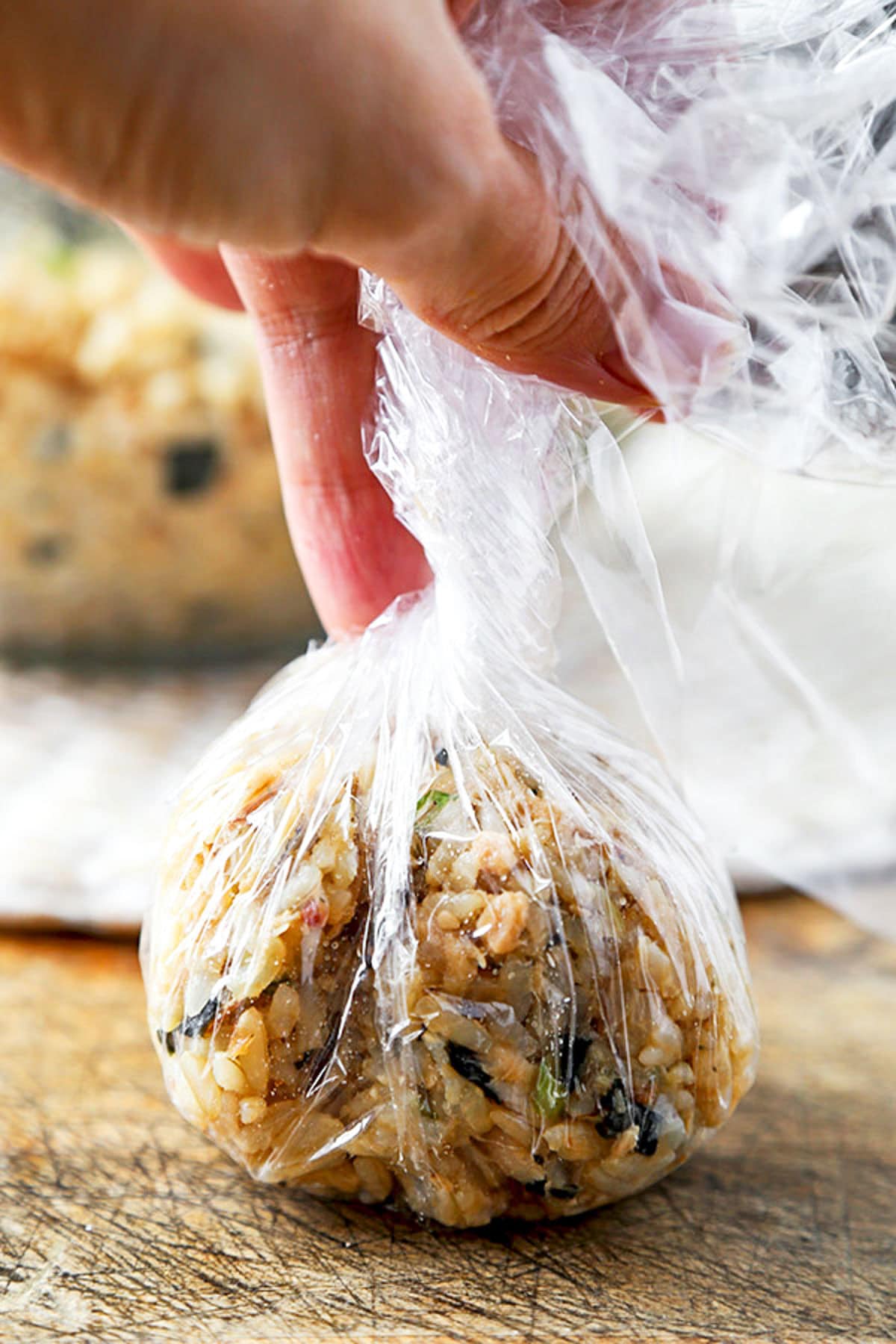
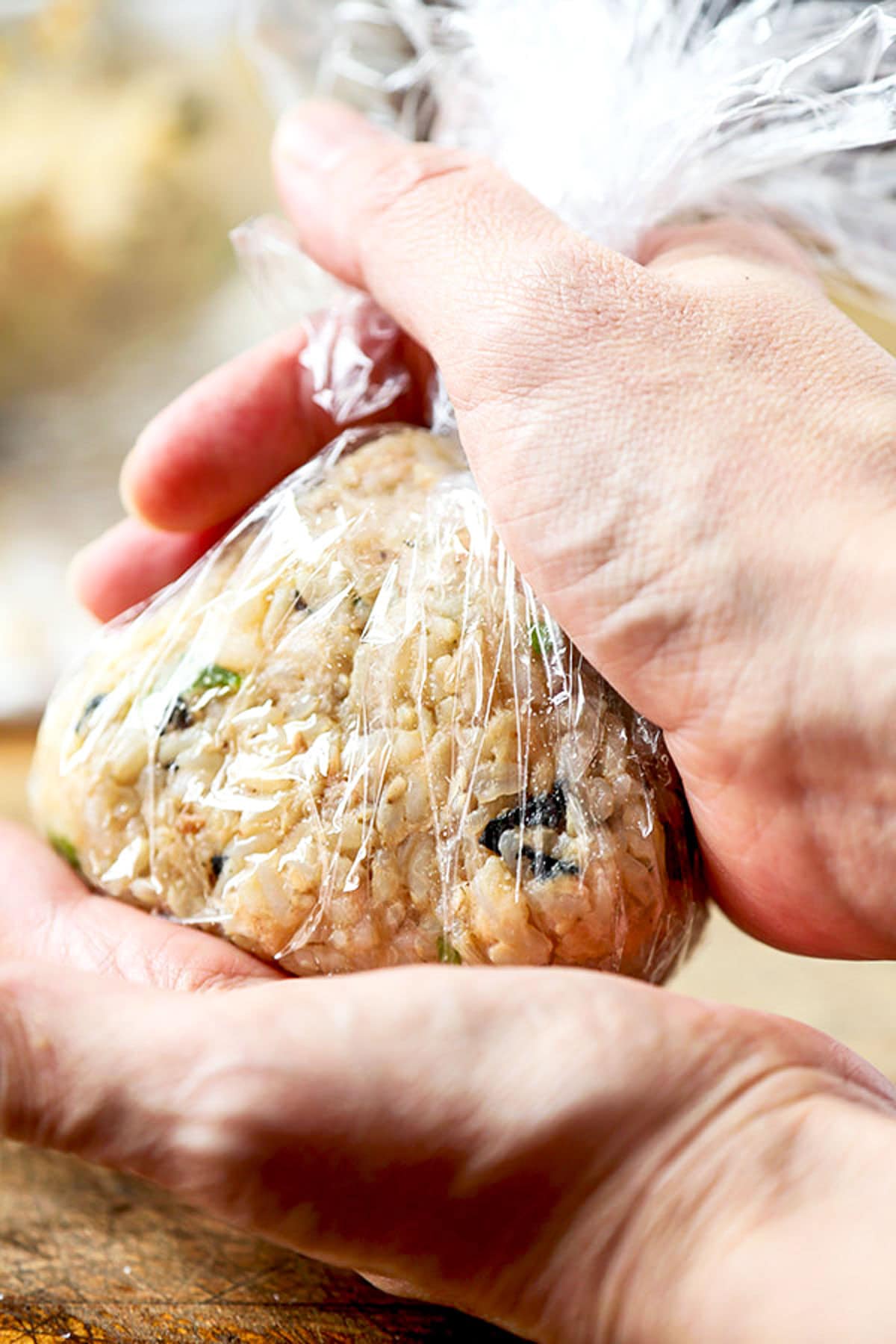
Expert Tips
Form the rice balls firmly, but gently. A good rice ball should be condensed enough that it doesn’t fall apart in your hands when you take a bite. Likewise, it shouldn’t be too tightly compressed or mashed into a hard block. Once the rice is formed and is holding its shape, I usually take a test bite. If the musubi holds up, I use that as a pressure guideline for the rest of the batch.
Try plastic wrap. Before I got comfortable handling rice balls in my bare hands, I used plastic wrap to hold things together. Add about 3/4 cup of rice mix into the center of a square of plastic wrap and twist the ends to seal. Then start molding the omusubi until it takes on a nice triangular shape. Don’t be intimidated by this! Even if the first ones look a little funny, they’ll taste amazing. And I love eating my mistakes.
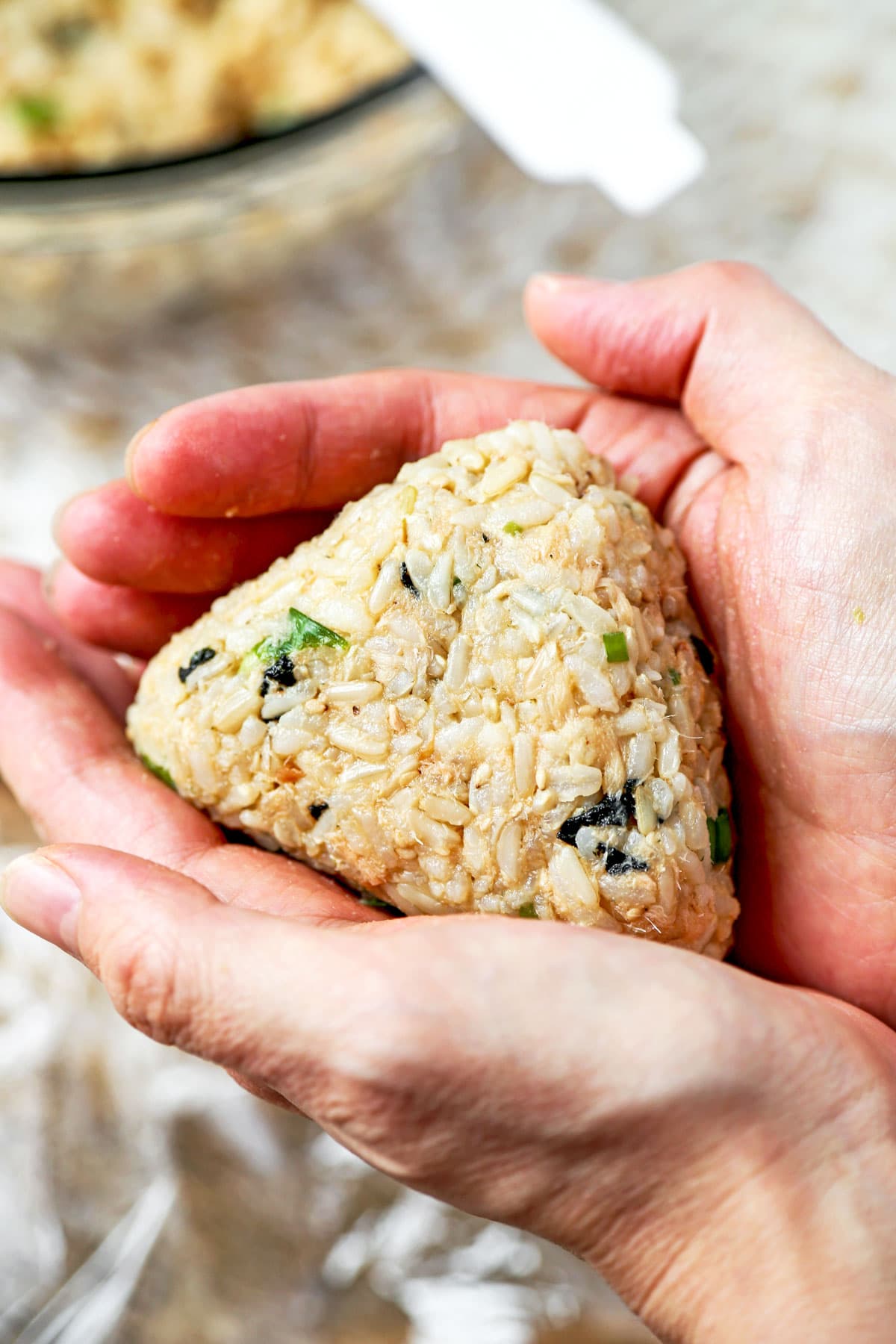
Storage and Reheating
Store leftover omusubi in the refrigerator for up to 2 days. I often make these ahead of time and keep them refrigerated, wrapped in plastic.
To reheat, zap them in the microwave for 20-30 seconds. If they’re still cold, go in additional 10 second increments until just right. They don’t need to be super hot, but cold rice has an unpleasant crunchy-chalkiness.
While rice can be frozen, I don’t recommend freezing these tuna omusubi. I’ve found that canned fish has a weird texture once thawed.
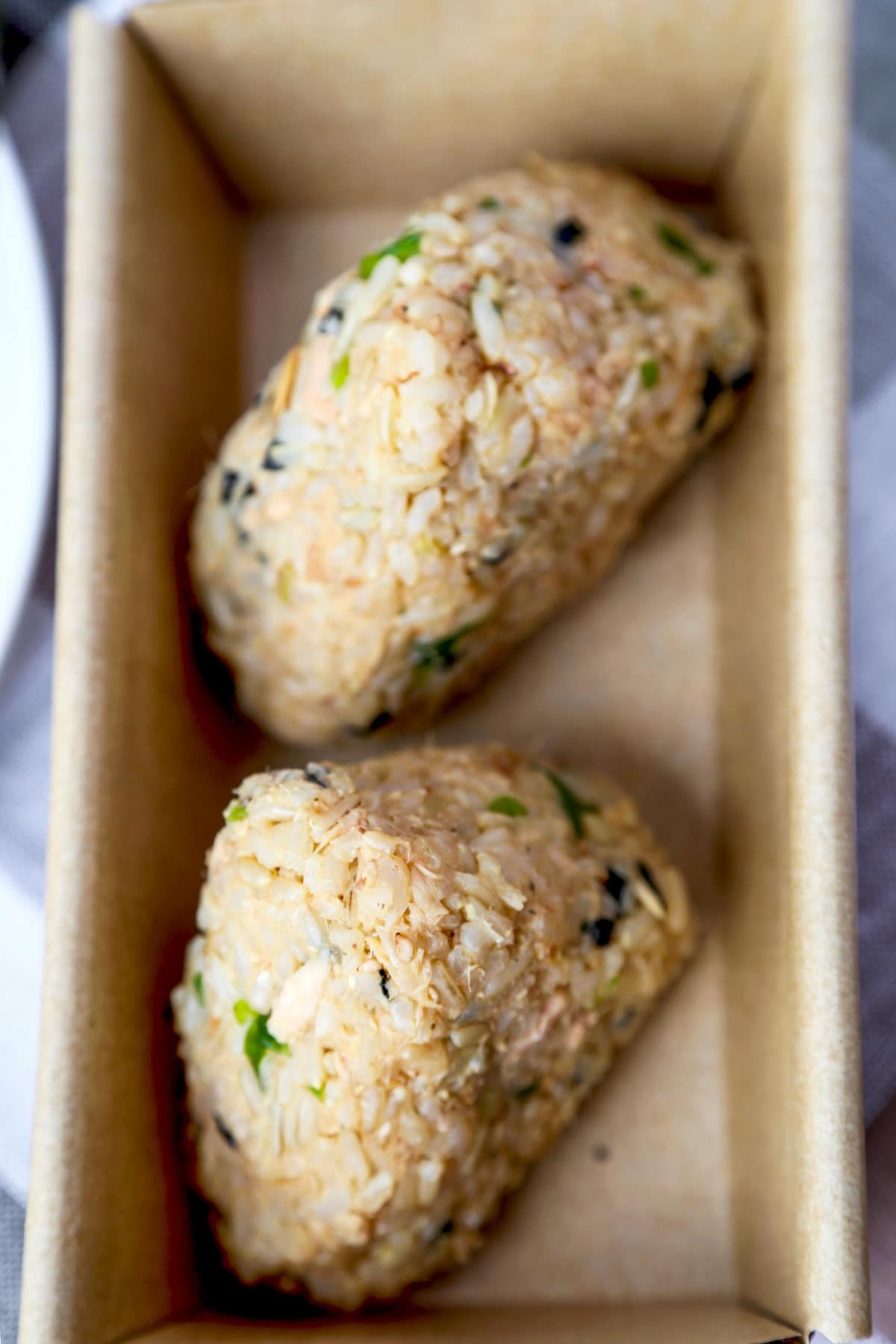
What I Serve With Tuna and Sesame Omusubi
When I make rice-centric things like inari sushi, musubi or grilled yaki onigiri at home, my mind immediately goes to entire meals comprised of small dishes like Japanese soups, salads and pickles. Here are some of my favorites.
- Goma-ae (Spinach Salad With Sesame Sauce)
- Miso Soup
- Green Salad With Japanese Carrot Ginger Dressing
- Kani Salad (Imitation Crab Meat Salad)
- Hijiki No Nimono
Frequently Asked Questions
Both call for Japanese short grain rice. But the main difference between sushi and omusubi is the way the rice is seasoned. Sushi rice contains a mix of rice vinegar, sugar and salt while omusubi is either plain or lightly salted.
They’re all Japanese rice balls. Musubi and onigiri can be used interchangeably. The ‘O’ in front of omusubi is an honorific used in the Japanese language to show respect and appreciation for something (in this case the rice). For example, it’s common to refer to mizu (water) as Omizu.
It’s important to properly drain the canned tuna before folding it into the rice. That water (or oil) can introduce too much liquid into the rice balls.
Yes! Even though I used seaweed in the filling, I still like to wrap these in seaweed sheets sometimes. Since I like the crisp crack of seaweed when biting into an onigiri, I only wrap them immediately before eating.
Did you like this recipe? Are there changes you made that you would like to share? Share your tips and recommendations in the comments section below!
Print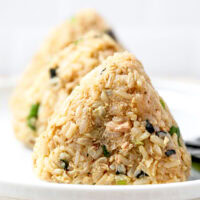
Tuna And Sesame Omusubi (Rice Balls)
- Prep Time: 20 minutes
- Cook Time: 0 minutes
- Total Time: 20 minutes
- Yield: 6 servings
- Category: Snacks
- Method: Hand Shaped
- Cuisine: Japanese
- Diet: Low Calorie
Description
No more uneven bites! I fold the seasoned tuna, katsuobushi and green onions into the rice itself for my mixed omusubi. Fun to make and ready in a flash.
Ingredients
- 1 1/2 cup cooked Japanese rice
- 1 1/2 cup cooked brown rice
- 5 ounces canned tuna in water
- 2 tablespoons bonito flakes (katsuobushi)
- 1 1/2 tablespoons sesame seeds
- 2 stalks green onions, finely chopped
- 3 tablespoons shredded nori
For the sauce:
- 1 1/2 teaspoons sesame oil
- 2 1/2 tablespoons soy sauce
- 1 1/2 tablespoons mirin
Instructions
- Drain the canned tuna. Put the canned tuna in a strainer and drain well. You can use a fork to gently press the tuna flakes and get rid of excess liquid. Set aside.
- Mix the white and brown rice. Put cooked white and brown rice in a bowl and using a rice paddle or spatula, fold the rice a few times until well mixed.
- Fold in the tuna and dry seasonings. Add tuna, bonito flakes, sesame seeds, scallions and shredded nori to the rice and mix well. Be careful not to mash the rice – folding the rice works best for this step.
- Add liquid ingredients. Add sauce and fold again until the rice is evenly coated and the liquid has been absorbed.
- Form the rice balls. Put about 3/4 cup of tuna and sesame rice on a piece of plastic wrap and twist the top. Slowly create a triangle shape by pressing the mixture from side to side. The omusubi should be packed enough not to crumble upon eating, with the rice intact (not mashed). Unwrap and finish shaping the omusubi in your hands. Alternatively, you can leave the omusubi wrapped and save it for later or to take to work the next day.
- Repeat the preceding step until all the rice has been used.
Different ways to eat omusubi:
- Just like that, bare and delicious!
- With a sheet of nori wrapped around.
- Grilled on one side.
Brush a little soy sauce on one of the flat sides of the omusubi and grill until the outer layer is golden brown and the rice almost crispy.
Notes
These tuna omusubi will keep refrigerated for up to 2 days.
Nutrition
- Serving Size: 1 rice ball
- Calories: 340
- Sugar: 2.1g
- Sodium: 290mg
- Fat: 7.1g
- Saturated Fat: 1.6g
- Unsaturated Fat: 2.7g
- Trans Fat: 0g
- Carbohydrates: 28.8g
- Fiber: 0.9g
- Protein: 37g
- Cholesterol: 60.6mg
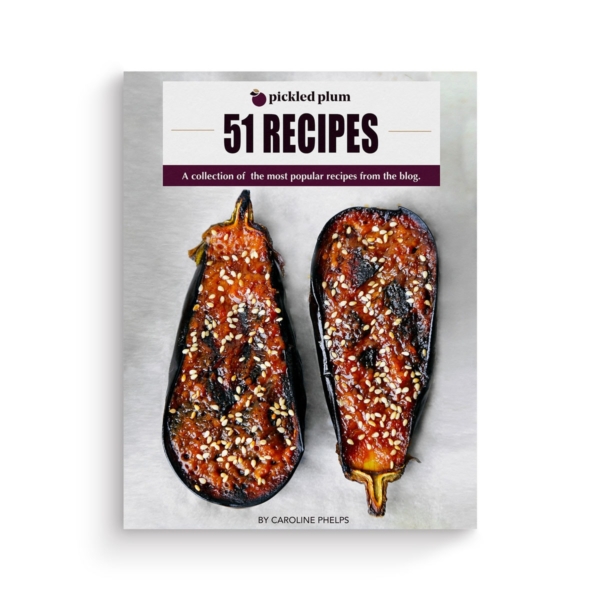
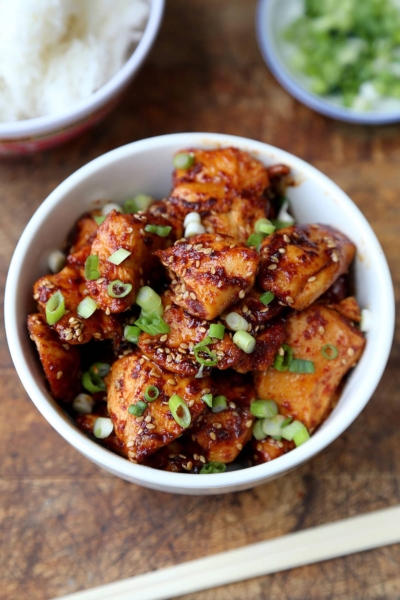
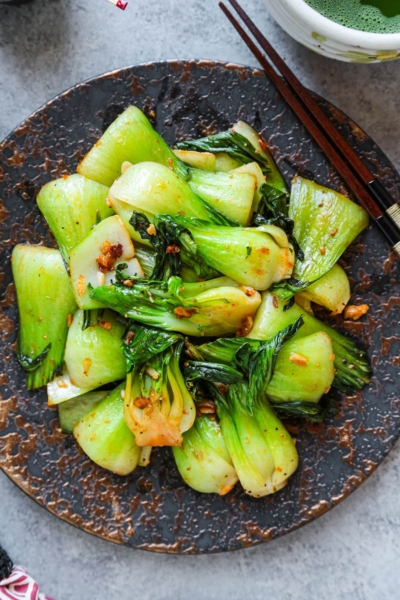
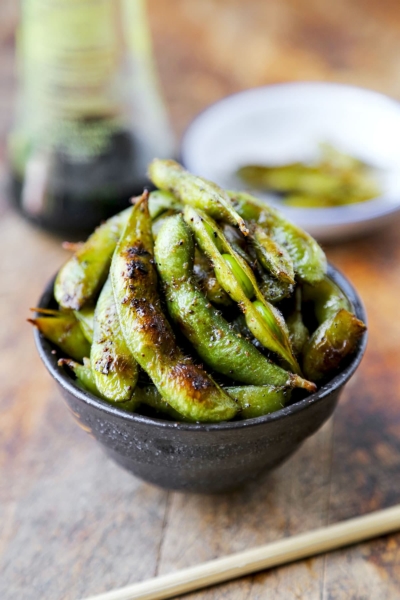
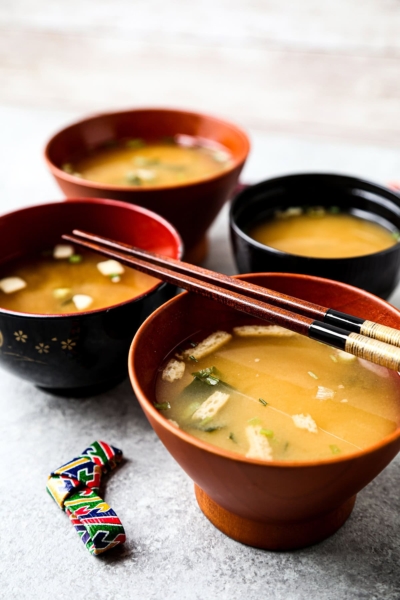
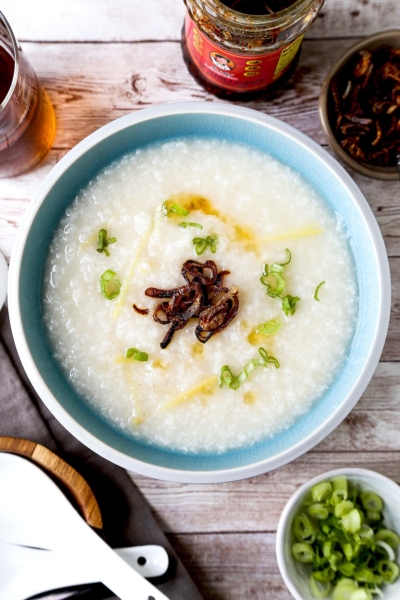









Oh, I love this! True story, I have always eaten Chicken of the Sea tuna since I was a little girl just because I loved the mermaid on their can 🙂 Great recipe, pinning to several of my boards. I followed you on social media as well!
I do have a questions for you: when I try and fry my onigiri, they always fall apart. Do you have a tip for me?
Hi Marissa, when you say fry, do you mean pan fry?
I think the problem may be the rice you are using – is it short grain or medium grain? Medium grain isn’t as sticky as short grain so I would suggest trying a different type of rice like Koshi Hikari or the Tamanishiki brand 🙂
I was wondering if I could get a calorie count this sounds yummy and don’t want to break my diet.
Hi Alexis, there are some calorie counters you can use for free such as https://www.verywell.com/recipe-nutrition-analyzer-4129594 . I used them in the past for my blog but stopped because I wasn’t sure if they were completely accurate – something to keep in mind when using them.